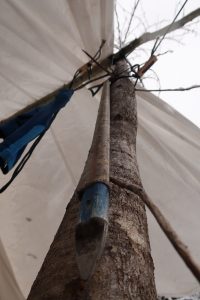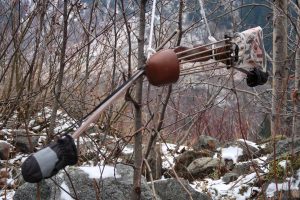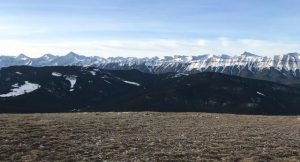
Could I do it? Climb a mountain twelve days in a row? The thought came to me when I saw the ultra-runners do repeats on Prairie Mountain. I did three in one morning in the spring, but certainly wasn’t feeling up to that now. I figured it was time to do something reflecting the signature line in some of my emails (from a Dylan Thomas poem): “Do not go gentle into that good night – Rage, rage against the dying of the light”. Just because; an ego-booster mostly, I think.
The original plan was to climb Prairie Mountain (2189m/7182ft), located West of Bragg Creek AB, once a day, for twelve days, leading up to Christmas. I started on a Sunday morning. On Monday morning, one of our vehicles had to be in the shop, and I found myself without wheels. End of plan, before it even started.
Luckily I have a hill behind my house that I can access. The climb up Prairie Mountain is 3.5km/2.2miles, and covers 700m/2297ft, give or take a few feet or meters, depending on the source. I mapped out a 100m/328ft climb on the hill stretching over just about half a kilometer. Go up and down 7 times and I’d have the same distance as the climb up and descent from PM. This would also save me the 90 min of driving required to get to PM and back. Not quite the same, but close enough.
Here are the notes I jot down every day after the “run”.
Day 1: Prairie Mountain
Weight: 61.2 kg / 134.8 lbs
Podcast: None
Average pace (uphill only): 15min 10 sec per km (24.2 min/mile)
Ran up Prairie Mountain in 53 minutes, forgot to record the descent. Pretty good time, about nine minutes longer than my personal best, but I was fitter then. Trail was icy, which probably will be the case every time. I wore hiking boots and crampons, hardly speed-record attire. The trail seems to attract more and more people that do repeats, climbing it several times in a row. There are a lot of fit people out there. I try to look the part whenever I see one coming, giving a knowing nod: “You and me, bud (or girl), we’re the fast ones on this hill, #ultrarunning”, only to get back to gasping for air once they have passed.
Day 2: Big Hill
Weight: 61.0 kg / 134.4 lbs
Podcast: Meateater Ep. 146: Bigfoot
Average pace: 11min 41sec per km (18.7 min/mile)
Felt good, legs a tad sore. Clearly I’m no speed demon. Going up this hill seven times is a bit boring, especially since I know it so well. No surprises, just grind. I jogged the downhills, need to be careful not to aggravate the back. The dog is getting slightly confused by all the back-and-forth.
Day 3: Big Hill
Weight: 61.0 kg / 134.4 lbs
Podcast: The Hunting Collective Ep. 39: Dusan Smetana
Average pace: 11min 30sec (18.4 min/mile)
Thank goodness for podcasts. Ben O’Brian of The Hunting Collective was talking to a former Czechoslovakian photographer who trains homing pigeons (and has a small farm with sheep, chickens, pigs, etc. with a taste for slivovitz and Argentinian asado). Leg 6 and 7 were starting to feel like work.
Day 4: Big Hill
Weight: 60.8 kg / 132.9 lbs
Podcast: Humans of Ultrarunning Ep. 1: Courtney Dauwalter
Average pace: 11min 47sec per km (18.9 min/mile)
I needed to go early today, so it would have less impact on the workday; still dark when I started. Legs were sore, so was the brain. Coutney Dauwalter is a beast, I am not. Or if we are both beasts, she is a wolverine, running high and low and never slowing down, and I am more of a lumbering bear past his prime, looking for a place to take a nap. If you don’t get the wolverine reference, you need to read Douglas Chadwick’s book “The Wolverine Way” and marvel about the relentless energy of this animal that inhabits the remote mountain ranges of the Rockies. Eleven deer on the hill. Managed to end strong, but it took a while to get the kinks out of the muscles; one third of the way there.
Day 5: Prairie Mountain
Weight: 60.8 kg / 132.9 lbs
Podcast: The Stickbow Chronicles Oct 14: Bowhunting Moose with Traditional Archery Gear Part 1
Average pace: 12min 46sec per km (20.4 min/mile)
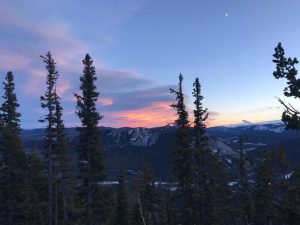
The real thing today! Started work at 7am so I could leave early, and make the top of Prairie Mountain shortly after sundown. There were only five people on the mountain, including me. The first two (hikers) I overtook on the uphill, so I looked good, and the other two (real runners) I met on the way down, so it was easy to play the part. Although if I really want to look like a runner, I will have to ditch the hunting pants.
Three minutes faster to the top than on Day 1! Must be the difference between wearing heavy hiking boots with spikes and wearing runners. Ran out of steam near the top. Had to lean left into the wind in order to maintain a straight line. Gusts up to 130km/h the weather people said.
The folks of the Stickbow Chronicles Podcast had Monty Browning on. Monty is a character who has been hunting Alaska for moose with traditional archery gear for years, successfully too. I love it when they find the oldtimers that have quietly been doing for decades what I am now trying to achieve. It teaches me to be humble and not brag too much about a few good shots at a target. Monty wrote a book about his exploits, available here: http://www.montybrowningbook.com/book. I haven’t read it, but if it is anything like the podcast it should be a good read.
I feel like the girl from the movie “Julie and Julia”. Is anybody actually reading this?
Day 6: Big Hill
Weight: 60.8 kg / 132.9 lbs
Podcast: TradQuest Ep. 21: Dick Robertson
Average pace: 10min 44sec per km (17.2 min/mile)
Dragging my butt out to the hill was not easy this morning. I decided to not look at my watch for at least half the distance, thinking I’d be slow. Surprise, surprise, kilometer 4 went in 10min 44sec, which also turned out to be average pace for the morning; fastest so far. I had expected a slow-down by now. Back to the real Prairie Mountain tomorrow.
My Fitbit claims I climbed 746m/2447ft, which I feel is overestimating it. Maybe I need a fancier watch, Santa? I like this one: https://www.coros.com/pace.php
On the earbuds today were the guys from the TradQuest podcast, interviewing Dick Robertson of Robertson Stykbow (www.robertsonstykbow.com). Another one of these guys that you won’t see chest pounding on IG, yet has taken several Dall sheep with his traditional bow. Dall sheep! Several! Wow.
Day 7: Prairie Mountain
Weight: 60.4 kg / 133.0 lbs
Podcast: Joe Rogan Experience Ep. 1212 David Goggins
Average pace: 13min 2sec per km (20.8 min/mile)
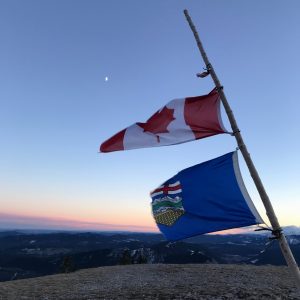 Saturday! Time to do the real thing! I opted for late afternoon, to give the crowds a chance to dissipate. The first two kilometers went OK, the last 1.5km of the climbs felt like I had ran the tank empty. Still bested my Day 1 time by about a minute.
Saturday! Time to do the real thing! I opted for late afternoon, to give the crowds a chance to dissipate. The first two kilometers went OK, the last 1.5km of the climbs felt like I had ran the tank empty. Still bested my Day 1 time by about a minute.
Some agony in the left knee, medial front, likely the result of too enthusiastic downhills, so took my time coming off the mountain. Tomorrow morning will be interesting, I expect a slow one.
Podcast of the day (in the truck, I don’t like tunes in my ear when I am on a trail): Joe Rogan interviewing David Goggins. Goggins has done some unbelievable things, athletically, which he does, he says, to strengthen his mind. I’m not doing it justice, so listen to the podcast if you want, or look at his book (“Can’t hurt me: Master your Mind and Defy the Odds”), also available as an audio book, read out by someone else, with per-chapter comments by Goggins.
Honestly, I find it very hard to listen to Goggins. I’ll say no more, whatever he does works for him in a big way.
Day 8: Prairie Mountain
Weight: 60.6 kg / 133.5 lbs
Podcast: Fred Bear’s Field Notes Oct 28 and Nov 11: Yukon Northwest Territory Part 1 & 2
Average pace: 12min 53sec per km (20.6 min/mile)
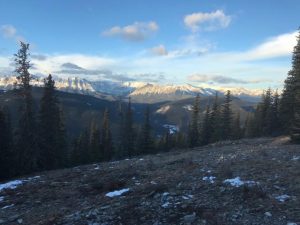
Tried to be smart about things (not an easy accomplishment) and started out just a hair slower. Still managed to be only 2 min slower than yesterday!
Eventful run. One of the six people that were on the mountain before me to see the sunrise failed to take the time for an outhouse break before heading up. He or she figured that 100 feet off the trail was good enough. My dog found the fresh ‘droppings’ adorned with TP. Yeah that happened. First I rubbed him down with handfuls of pine needles, to get most of the solids out, and later tried to clean him up a bit more with snow. The river was a welcome sight, and I managed to get him presentable enough to ride in the truck.
Halfway down a misstep and a fall; cut a flap of skin (little flap) off my hand, causing a decent bleed, so some field emergency patching was in order (the other people on the trail might have gotten a bit screamish seeing me come jog down with hand dripping with blood and dog stinking up a storm.
Bear Archery has started a podcast where a fellow reads out chapters from Fred Bear’s book “Field Notes”, which are the daily thoughts Fred put to paper during his many hunts in Africa, Yukon, NWT, BC, etc. Fairly dry, but, to me anyway, interesting. To have so much time (and resources) to travel and hunt; unthinkable these days, for most of us.
Day 8 in the books, 2/3s of the way there. Happy that I am still managing a fair pace. Going to try to fit the real mountain in two more times, and two more on the hill behind the house.
Day 9: Big Hill
Weight: 60.4 kg / 133.0 lbs
Podcast: Randy Newberg’s Hunt Talk Radio Ep. 95 Henry Mountain Free Range Bison Hunting
Average pace: 12min 25sec per km (19.9 min/mile)
Pre-dawn start today, as the workday is full and will go past dinner. Legs had no go today; couldn’t push uphill, and couldn’t trust myself to jog on the downhill. Hopefully I will recover a bit before going back to the mountain tomorrow.
Randy Newberg chattered in my ears, along with a bunch of merry men. They recorded the podcast on the tail end of their archery bison hunt in Utah’s Henry Mountains. A day-by-day of this hunt is available on his Youtube channel. In the podcast they talk about bison, how they were rescued from extinction at the very last moment, and the fight it took to create Yellowstone NP and enable enforcement of the park status. This story is featured in the book “Last Stand”, detailing the life of George Bird Grinnell. Go read it, it is a good one.
Day 10: Prairie Mountain
Weight: 60.6 kg / 133.4 lbs
Podcast: Ginger Runner LIVE: Ep. 198 Sally McRae: The comeback at Tarawera 100
Average pace: 12min 1sec per km (19.2 min/mile)
So stoked about today’s run! Managed to stay a hair under 50 minutes. After yesterday’s crawl on the Big Hill, I couldn’t be happier. The fastest time yet up the real mountain of this 12-day endeavour. Not bad for Day 10.
Ethan Newberry and his wife Kim run the Ginger Runner LIVE podcast (you can also watch them weekly on Youtube). Sally McRae (@yellowrunner on IG) was their guest, after she won the Tarawera 100. Sally is such a positive person, it almost hurts. Impossible to stay grumpy, listening to her talk.
Two more days, one boring hill-repeat session tomorrow, finishing Thursday afternoon. Hope the weather holds, today the winds were howling on the ridge.
Day 11: Big Hill
Weight: ? kg / ? lbs
Podcast: Kifarucast Ep 76: Hunting Partners with David Hoff
Average pace: 10min 33sec per km (16.9 min/mile)
Started with some anxiety, feeling a bit worn after yesterday’s fast climb, but with the first three kilometers sub-11 min/km I got a bit more excited, and ended with the fastest time on the hill to date! I have to say, this is not at all going as I expected (much better!). Off to the real mountain tomorrow, for a final hike, accompanied by my daughter, who came home for Christmas. May even take a selfie!
On the podcast today, Aron Snyder and Frank ‘the Tank’ Peralta from Kifarucast. Aron doesn’t need much of an introduction. “I was shivering like a cat shitting razor blades”, is just one of the colourful expressions that lace Aron’s vocabulary. But more than an entertaining choice of words, Aron has transformed into a fantastic recurve hunter, in a relatively short period of time. Lots of practice and good coaching pays off apparently; go figure. Today they were talking with David Hoff, ultrarunner and longbow hunter. Best of both worlds! Don’t listen if you cannot stomach strong language.
One more day! One more climb!
Day 12: Prairie Mountain
Weight: 61.2 kg / 134.8 lbs
Podcast: none – chatting with my daughter
Average pace: did not record
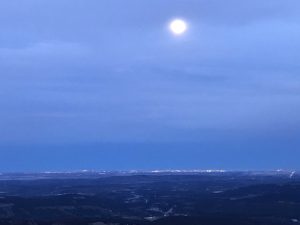
Last day. Big winds right out of the truck, and it didn’t let up much as light faded. Flurries coming in from the West, and clouds muting the rising moon in the East. We hiked out in the dark.
As often the case, after a challenge is completed, it doesn’t feel like all that important anymore. Twelve days of “Prairie Mountain”; six times a surrogate, six times the real thing. It is done.
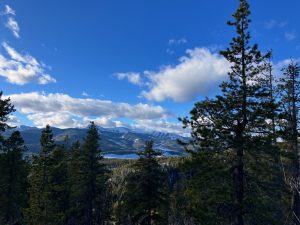
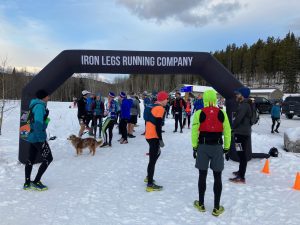
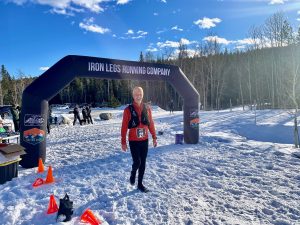
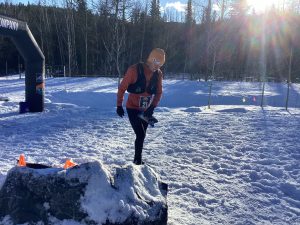 (Looking sharp for the finish photo / empty tank)
(Looking sharp for the finish photo / empty tank)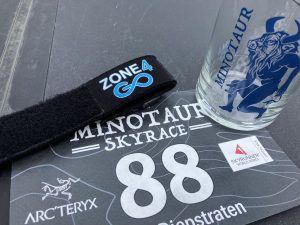
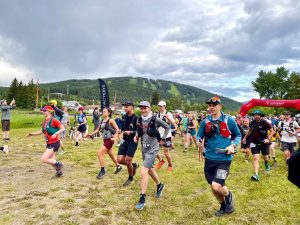
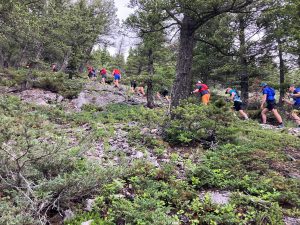
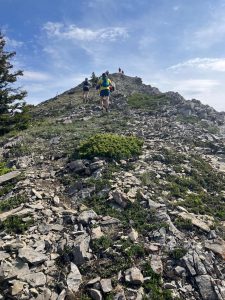
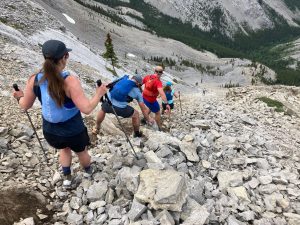
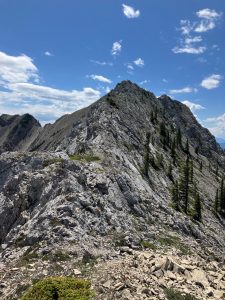
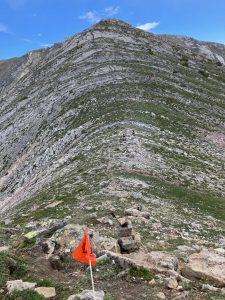 The long way down hurts. The trail becomes lonely, nobody is catching up, and I’m not catching anyone. Legs are empty. Focus wanders, and I trip. On a soft trail, very lucky. Checking the watch, I realize that a sub-nine hour finish is in reach, much better than the pre-race doom had allowed for. The descent seems never-ending, I’m glad for the poles that take some pressure of the legs. A few people pass me, I’m having trouble keeping a good pace on anything steep downhill.
The long way down hurts. The trail becomes lonely, nobody is catching up, and I’m not catching anyone. Legs are empty. Focus wanders, and I trip. On a soft trail, very lucky. Checking the watch, I realize that a sub-nine hour finish is in reach, much better than the pre-race doom had allowed for. The descent seems never-ending, I’m glad for the poles that take some pressure of the legs. A few people pass me, I’m having trouble keeping a good pace on anything steep downhill.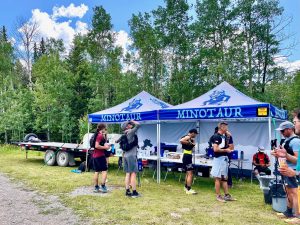
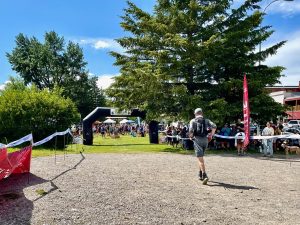

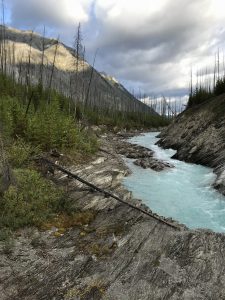 We started at the Floe Lake trailhead around 8:20AM. Right off the parking lot we dropped down to a bridge across the Kootenay River. A small group of runners was getting ready, but we were gone before they got organized. After crossing, I said goodbye to my daughter and the mutts and started a slow jog up a meandering trail that ran through a giant burn. Walking the steeper bits, jogging where I could, I made decent time, passing a few hikers, meeting some backpackers on their way out, and hearing for the first time about a group of runners ahead of me.
We started at the Floe Lake trailhead around 8:20AM. Right off the parking lot we dropped down to a bridge across the Kootenay River. A small group of runners was getting ready, but we were gone before they got organized. After crossing, I said goodbye to my daughter and the mutts and started a slow jog up a meandering trail that ran through a giant burn. Walking the steeper bits, jogging where I could, I made decent time, passing a few hikers, meeting some backpackers on their way out, and hearing for the first time about a group of runners ahead of me.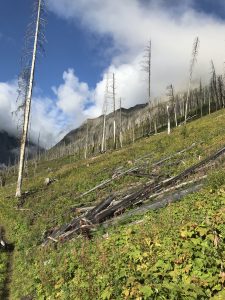 The last few kilometers up to Floe Lake were steep! No running here for me, just grind uphill. Weather was good, legs still felt OK, scenery was great. Floe Lake was rather bleak-looking, bordered by towering grey rock, jutting into a now overcast sky, a stark contrast from the lush, green, sun-filled valley below.
The last few kilometers up to Floe Lake were steep! No running here for me, just grind uphill. Weather was good, legs still felt OK, scenery was great. Floe Lake was rather bleak-looking, bordered by towering grey rock, jutting into a now overcast sky, a stark contrast from the lush, green, sun-filled valley below.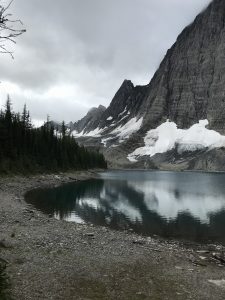
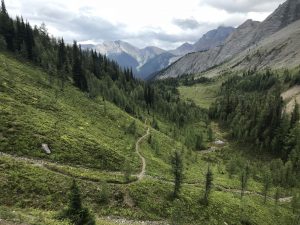
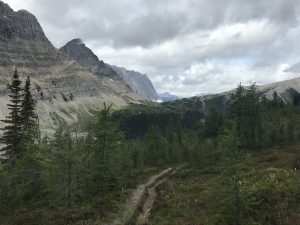
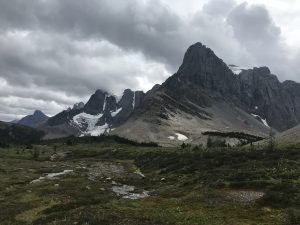
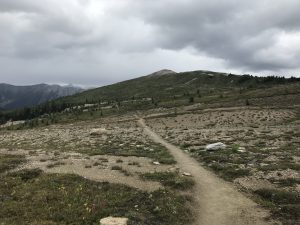
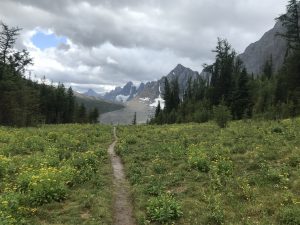
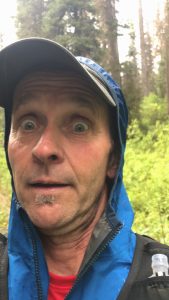
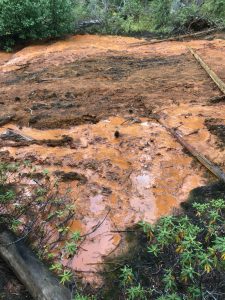
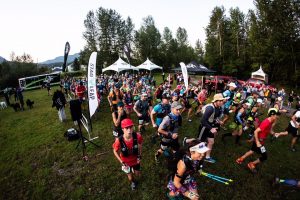
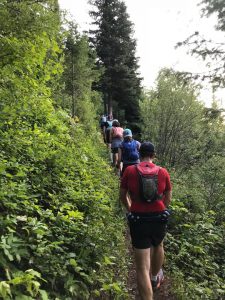
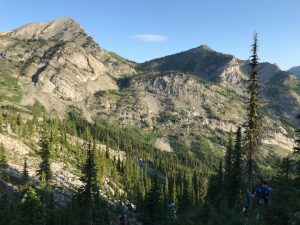
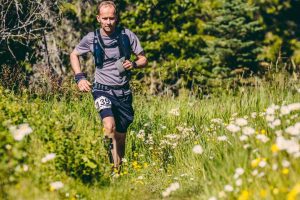
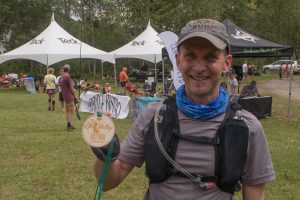
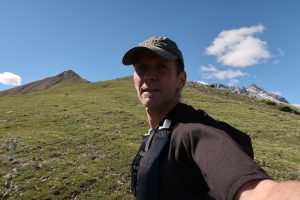
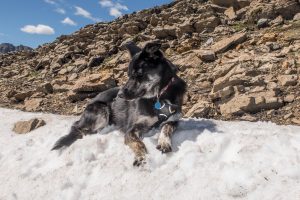
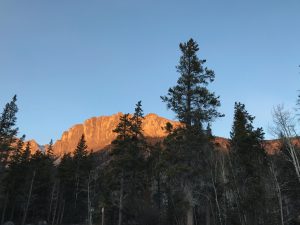
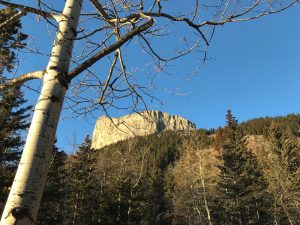
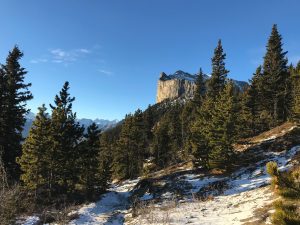
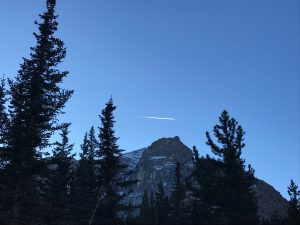 ame apparent how cold it really was
ame apparent how cold it really was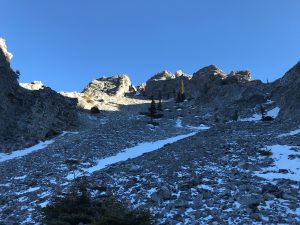
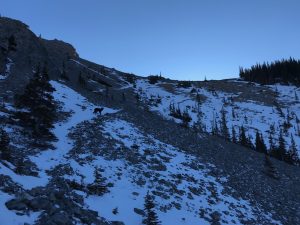
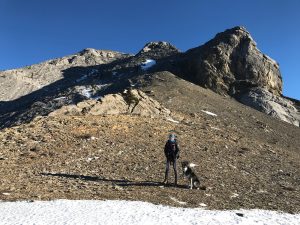
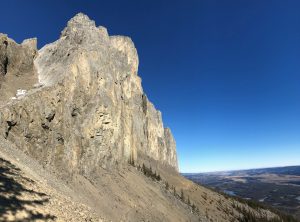
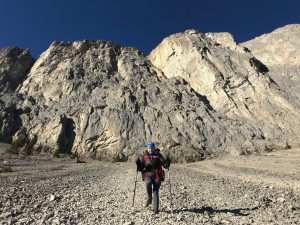 Gentle trail through the aspens to conclude the circumambulation
Gentle trail through the aspens to conclude the circumambulation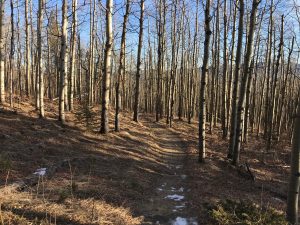


 Saturday! Time to do the real thing! I opted for late afternoon, to give the crowds a chance to dissipate. The first two kilometers went OK, the last 1.5km of the climbs felt like I had ran the tank empty. Still bested my Day 1 time by about a minute.
Saturday! Time to do the real thing! I opted for late afternoon, to give the crowds a chance to dissipate. The first two kilometers went OK, the last 1.5km of the climbs felt like I had ran the tank empty. Still bested my Day 1 time by about a minute.

